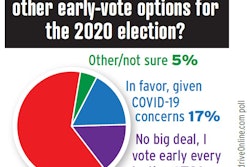
Should gerrymandering of electoral districts — to favor one political party over another — be legal?
With resident data capable of being crunched in ways that were previously unimaginable, evidence around the nation has shown a rise over time in creatively drawn electoral districts many see as clearly designed to favor one party over another. “I’ve seen some really convoluted districts that at points were only a block wide but stretched for 100 miles,” noted reader Alex Carlucci, commenting under Overdrive polling about the issue.
Given most state legislatures’ control of the redrawing process, partisan incentives for gerrymandering are baked into the process. FiveThirtyEight.com’s “Gerrymandering Project” called the drawing of political maps an increasingly “partisan arms race” recently, and it’s one that the new U.S. House of Representatives, now with the Democratic Party in the majority, highlighted with its first introduced piece of legislation of the 116th session. H.R. 1 is a grab-bag of measures destined never to see the light of day together, given Republican opposition to many policies that would be enshrined in law if it did.
At once, however, a prohibition on partisan gerrymandering is part of the bill and could be broken out in separate legislation. As shown in the Hot Buttons poll on this page, disfavor for partisan gerrymandering of districts seems to cut across partisan divisions. 87 percent of Overdrive readers either noted simply that it should not be legal or that independent state commissions would be appropriate arbiters of district boundaries with a goal of taking politics out of the process, to the degree that’s possible.

The H.R. 1 method of combating gerrymandering is to require such independent commissions, a reality in a few states today. Carlucci proposed another: “The voting commissioner should use a computer to start at one end of the state and go to the other, dividing the districts by population.”











